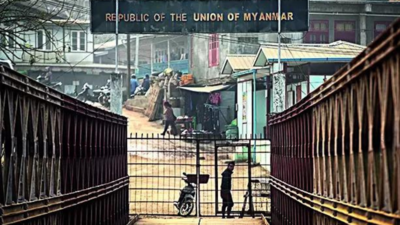
NEW DELHI: India has stepped-up work on fencing the 1,643-km porous border with Myanmar, which will be completed by the Border Roads Organisation (BRO) in phases over the next 10 years.
The ongoing ambitious project will entail around Rs 20,000 crore being spent on the fence itself and another Rs 11,000 crore on construction of over 60 border roads.
“As per the survey conducted by govt agencies, over 1,500-km of fencing – which includes 300-km of electric fencing – is required for effective management of the India-Myanmar border as well as ensuring security and stability of India’s north-east region,” Army sources told TOI.
The fencing comes at a time when there are still no signs of normalcy returning to conflict-torn Manipur, where over 250 people have been killed in ethnic violence between the Kuki-Zo and Meitei communities since May last year.
While over 60,000 people have been internally displaced, less than half of the around 6,000 weapons looted in the state have been recovered forces so far by security.
The volatile situation in Myanmar amid the fighting between the military and armed opposition outfits over the last one year, subsequent to the coup in Feb 2021, has also led to over 31,000 people fleeing and seeking refuge in India.
“Myanmar’s ongoing instability has further aggravated the situation, with a surge in smuggling, human trafficking and movement of armed infiltrators. Drugs worth Rs 1,125 crore, for instance, have been seized along the border in the last six-seven months,” a source said.
Some communities in Manipur, Nagaland, Mizoram and Arunachal Pradesh, all of which border Myanmar, have however strongly opposed the proposed fence as well as scrapping of the ‘Free Movement Regime‘, which allowed people residing along the border to venture 16-km into each other’s territory without visas, earlier this year.
Apex Kuki bodies, for instance, say the twin steps “threaten to infringe upon the cultural, traditional and historical rights of indigenous communities”.
Some experts have also criticised the “costly” move, stressing it will cause hardships to people who share ethnic ties across the border as well as disrupt closer connectivity, trade and people-to-people ties.
The defence and security establishment, however, contends the fencing does not intend to restrict the movement of civilians or sever cultural and familial connections on either side of the border.
“A network of gates with biometric systems along the fence is being planned to allow cross-border movement, while ensuring security. The locations of these entry and exit points will be decided through collaborative consultations with local residents,” another source said.
The fencing’s primary objective is to curb “the movement of armed groups”, as well as stem the smuggling of weapons, drugs, human trafficking and illegal immigration, he added.
The “success” of the 10-km fencing completed in Moreh (Manipur) underlines the project’s potential to improve both security and trade management.
“The fencing will also regulate and boost legitimate trade, ensuring economic benefits for the local communities while eliminating the adverse impact of illegal trade,” he said.

